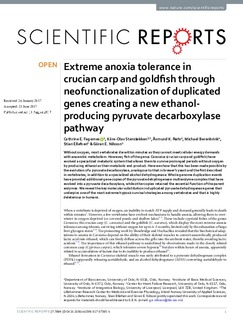Extreme anoxia tolerance in crucian carp and goldfish through neofunctionalization of duplicated genes creating a new ethanol- producing pyruvate decarboxylase pathway
Fagernes, Cathrine Elisabeth; Stensløkken, Kåre-Olav; Kjendseth, Åsmund Røhr; Berenbrink, Michael; Ellefsen, Stian; Nilsson, Göran Erik
Journal article, Peer reviewed
Published version
Permanent lenke
http://hdl.handle.net/11250/2476215Utgivelsesdato
2017Metadata
Vis full innførselSamlinger
Originalversjon
10.1038/s41598-017-07385-4Sammendrag
Without oxygen, most vertebrates die within minutes as they cannot meet cellular energy demands
with anaerobic metabolism. However, fish of the genus Carassius (crucian carp and goldfish) have
evolved a specialized metabolic system that allows them to survive prolonged periods without oxygen
by producing ethanol as their metabolic end-product. Here we show that this has been made possible by
the evolution of a pyruvate decarboxylase, analogous to that in brewer’s yeast and the first described
in vertebrates, in addition to a specialized alcohol dehydrogenase. Whole-genome duplication events
have provided additional gene copies of the pyruvate dehydrogenase multienzyme complex that have
evolved into a pyruvate decarboxylase, while other copies retained the essential function of the parent
enzymes. We reveal the key molecular substitution in duplicated pyruvate dehydrogenase genes that
underpins one of the most extreme hypoxic survival strategies among vertebrates and that is highly
deleterious in humans.
